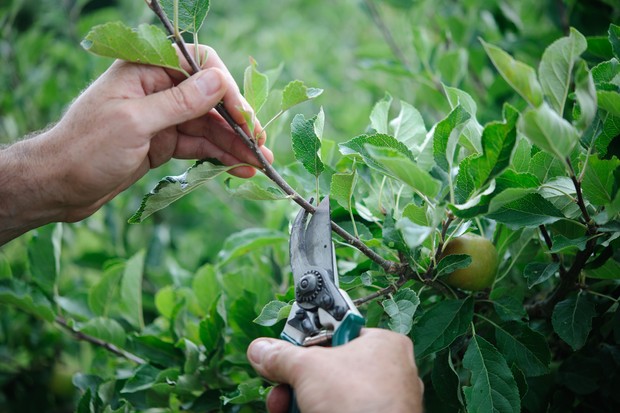
Summer pruning is an often overlooked task, but if anything, it’s just as important as chopping plants back when they are dormant in winter.
Cutting back plants in summer has a host of benefits, not least in helping to restrict the size of your plants and stopping them outgrowing their allotted space. It can also promote future flowering and fruiting.
BBC Gardeners’ World Magazine offer:
Online Masterclass: Perfect Your Pruning in Autumn/Winter
Discover how to take the headache out of pruning to get the best results from the plants, in this online Masterclass, including live Q&A.
Book now to master your pruning skills
More on pruning plants:
Discover eight reasons to prune in summer, below.
Summer pruning is an often overlooked task, but if anything, it’s just as important as chopping plants back when they are dormant in winter.
Pruning encourages more fruit buds
Pruning an apple tree in summer
Many fruit trees including apples, crab apples, medlars and mulberries produce a crop on short flowering spurs along the bottom half of branches. These don’t need pruning, but cutting back vigorous growth made in spring will encourage more productive growth to develop.
Find out how to prune fruit trees in summer.
Pruning prevents disease

Pruning a plum tree in summer
Trees in the cherry family Prunus are prone to silver leaf disease. Pruning in summer helps to avoid infection, as the fungal spores are airborne between September and May. This is also the time to prune out any branches that are weak, competing or crossing.
Discover how to prune plants to avoid disease.
Pruning removes old fruited wood

Pruning old blackcurrant stems
After a few years, the productivity of fruit bushes like blackcurrants and jostaberries will decline. Prune back the thickest, oldest stems at the base as soon as you’ve picked the currants, leaving a few of the younger, fruited stems and the strongest new growth to crop in the future.
Pruning restricts the size of fruit bushes

Pruning a gooseberry bush
Left unpruned, fruit bushes including gooseberries, redcurrants and whitecurrants can outgrow their space. Pruning back the youngest, current season’s growth limits the size of plants and encourages more productive sideshoots to form.
Learn how to prune fruit bushes.
Pruning encourages new growth

Pruning old raspberry canes
With the exception of autumn fruiting raspberries, cane fruits like blackberries, loganberries and summer raspberries produce new canes each year, which will go on to fruit the following summer. Old, fruited canes can be cut down to the ground to make space for new stems.
Take a look at our top tips for pruning cane fruit.
Pruning promotes better flowering

Pruning the whippy growth of wisteria in summer
Climbers including honeysuckle, jasmine, star jasmine and wisteria can be a tangled mess by the end of the season. Pruning in summer removes masses of soft, nitrogen-rich growth, and if repeated every year, will gradually allow flower-promoting potash to build up in the plant.
Find out how to prune climbers for better flowers and prune wisteria in summer.
Pruning keeps shrubs in shape

Pruning old philadelphus stems
Overgrown shrubs produce their flowers high up on the plant, where they can’t be seen. Anything that flowers from early winter to late spring, like deutzia, forsythia, kerria, philadelphus and weigela can be pruned in summer.
Read more about pruning spring-flowering shrubs in summer and overgrown garden problems.
Pruning helps train shrubs

Pruning a young cercis
Early training and shaping of shrubs like berberis, cercis, chaenomeles, deutzia and viburnum is crucial for creating a strong framework of branches and better flowering in the plant’s early years.
Discover how to prune newly planted shrubs.
